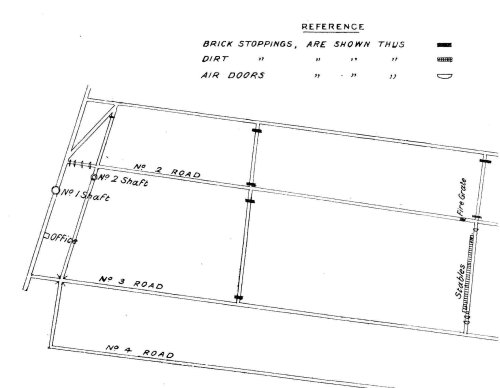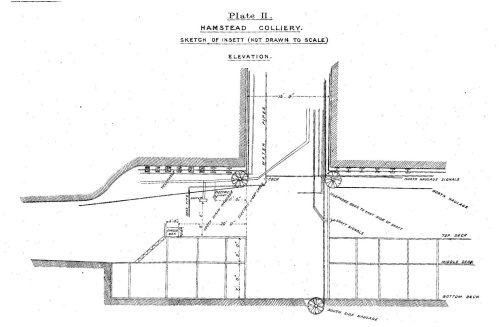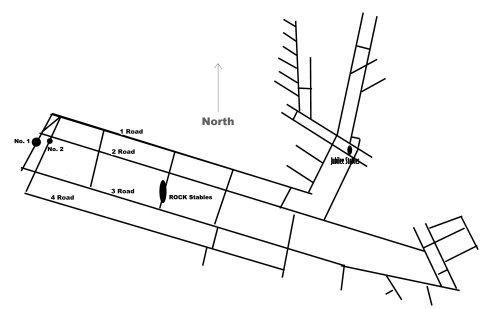Layout and operation of the mine in 1908
In order to understand some of the issues relating to the Hamstead fire it is useful to outline the layout and operation of the mine.
Two shafts served the mine, the main No 1 shaft was fifteen feet in diameter and it was this that was normally used for the transport of men and coal to and from the seams The smaller No 2 shaft was used for the emergency transport of men and was a key player in the ventilation of the mine.
There were two seams of coal, a thin seam about 2 feet 6 inches (75cm) thick known as the “brooch coal” level and the “thick coal” seam some 40 yards (36m) below the “broach coal” seam.
After a bad fire in 1898 part of the No. 1 shaft had been filled in at the bottom. When re-opened the shaft only went down to the thin 'brooch coal' level at about 580 yards. New roads were cut North and South to connect to the workings which then went East. At about 600 yards there was an 200 yard incline of 1 in 5 down to the thick coal seam workings some 40 yards below.

Layout of mine around the shafts
Four roads were cut to the seams. The roads were separated by wooden and metal air doors and by dirt and brick stoppings. This allowed the air to flow around the mine and meant that sections of the mine could be secured in case of fire.
The ventilation of the mine was achieved by using a Guibal fan near at the top of the No.1 shaft. The fan was 36 feet in diameter, had eight blades 11 feet 6 inches wide which was purchased second-hand in 1886. This produced a stream of air that passed around the mine and returned up and out through the No. 2 shaft. The passage of air was assisted by lighting a fire in a grate at the bottom of the No. 2 shaft creating an updraft. In each of the two return roads there were fire grates to assist the flow. One was 620 yards in on The No 4 East Road, the other being 430 yards along No 3 Road. All together a current of 70,000 to 72,000 cubic feet of air was created down the shaft.
At the bottom of the No 1 shaft was a wooden platform with three decks that allowed the loading of coal tubs and men into the lift cage.

Diagram of Bottom of No 1 Shaft
The mine had two underground stables. The first nearer the shafts was known as the Rock Stables, whilst the other deep in the working were known as the Jubilee Stables.
The outline plan below shows the extent of the mine roads.

Outline Plan of the Roads in Hamstead Mine
Next the Start of the Fire
Information
- The HAMSTEAD MINERS MEMORIAL TRUST is a registered Charity No.1098711
- We welcome information and photographs on Hamstead Colliery and Great Barr
